Dorothy Tyler was a British high-jumper who competed in four Olympics over a 20 year period. Her experiences couldn’t be more different from what modern athletes will experience in Tokyo.
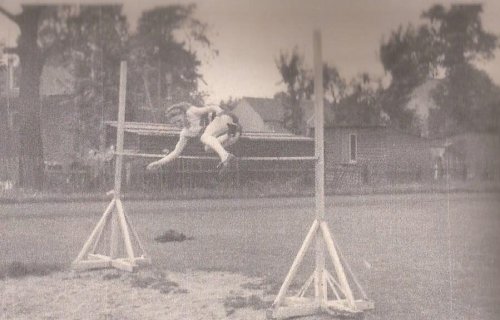 Dorothy Tyler training, photo courtesy Dorothy Tyler
Dorothy Tyler training, photo courtesy Dorothy Tyler
Dorothy Tyler was a 4 time Olympian in the High Jump. The Olympics she competed in (1936, 1948, 1952 and 1956) all were held in times that celebrated the needs for an Olympics and the challenges of the modern world.
Dorothy Tyler
Dorothy Tyler was just 16 when she competed in the 1936 Olympic women’s high jump. She earned her selection by breaking British record earlier in the season.
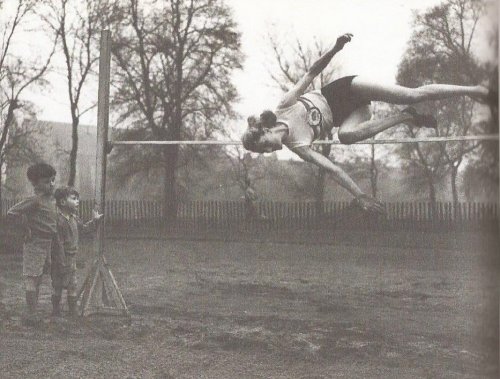 Dorothy Tyler training, photo courtesy Dorothy Tyler
Dorothy Tyler training, photo courtesy Dorothy Tyler
Looking back it is amazing how different the Olympics were. Dorothy told me: “The Olympics were very low key with very little in the papers about it – much more about possible war”. Even though she had won a silver medal as a 16 year-old, she had no recollection of much interest in her achievement: “No fuss was made of us. I did no interviews”. And she was the first British woman to win an individual Olympic medal in athletics!
One surprise on arriving in Berlin was that the Olympic Village was just for men: “Women were not allowed in the Olympic Village! We stayed in a women’s PE college, which was comfortable enough and with a training track. But because we were not in the village the only time we met the British men during the games was if we saw them at the stadium”.
One abiding memory was how political the games were: “I remember arriving in Berlin and seeing nothing but Hitler youth and giant swastikas everywhere”. She also had a clear memory of how “the stadium went mad” when Hitler entered.
It was 75 years after the event when I spoke to her but she had some very clear memories of the event:
- The excitement at just 16 of going to another country and to her first major international event;
- Speaking to Jesse Owens and getting his autograph;
- Meeting a young Danish athlete at training, who asked her out but management would not allow her to go!
As far as the competition went, it was a bittersweet experience. She had to wait to the last day of the programme. Her approach was to keep everything normal: “I just treated the Olympics as another competition for my club. It was just the high jump as far as I was concerned and I just jumped”. In those days she was very much on her own with no coach. She was delighted to do so well and come away with a silver medal. Ibolya Csák (Hungary), Elfriede Kaum (Germany) and Dorothy Odam (her maiden name) all jumped 1.60 to tie.
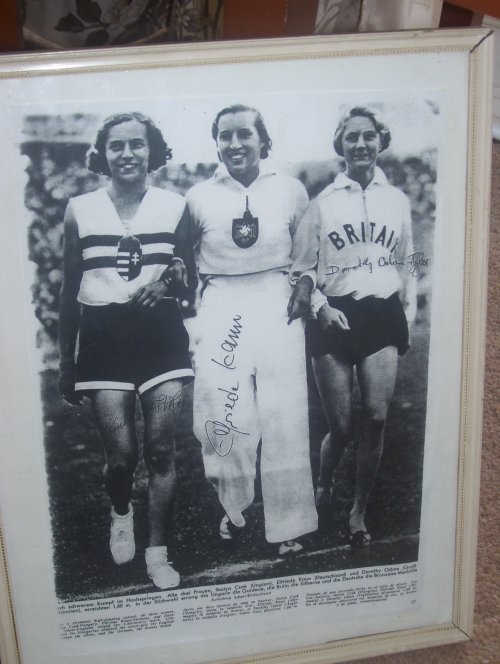 1936 Olympics: Ibolya Csák (Hungary), Elfriede Kaum (Germany) and Dorothy Odam, photo courtesy Dorothy Tyler
1936 Olympics: Ibolya Csák (Hungary), Elfriede Kaum (Germany) and Dorothy Odam, photo courtesy Dorothy Tyler
However Dorothy was quick to point out that under today’s count-back rules she would have had gold: “In 1936 it was a jump off to decide the medals. They kept putting the bar up and down until one person jumped a height that the others didn’t. Because I had cleared 1.60 with my first jump while Csák failed her first jump, under current rules I would have won. Ironically I had equalled the Olympic record but did not get the gold medal”.
 1936 and 1948 medals, photo courtesy Dorothy Tyler
1936 and 1948 medals, photo courtesy Dorothy Tyler
Dorothy competed in the 1936, 1948, 1952 and1956 Olympics but was deprived to the chance to compete in 1940 and 1944.
“I would have gone to Tokyo Olympics in 1940 as the world record holder but the war broke out. There were no Olympics in 1944. By 1948 I was married with two children and was doing less training! For the 1948 Olympics in London, we were staying in a rather run down place at Victoria, central London. We trained at Motspur Park in South London but they only took us once. I remember jumping off grass, which I’ve always thought was better than cinders, and I jumped really high – so high that I didn’t dare tell anyone in case I couldn’t do it again!”
In 1948 Dorothy again finished first equal but by 1948 the rules had changed and the winner was decided on count-back when Dorothy and Alice Coachman each jumped 1.68. Ironically the rule change acted against Dorothy who lost on count-back. As Coachman had injured her back, Dorothy felt that she could not have managed a jump-off. The outcome as she put it was: “Under today’s rules I would have got the gold medal in Berlin. And under the 1936 rules I would have got gold in London 1948 but all I’ve got his two silvers”.
Dorothy also had a bit of bad luck in the decisive jump: “My bra snapped in my first attempt at 1,68 And I missed it while Coachman got the height first time, so she won”.
She competed in the 1952 Olympics in Helsinki and came seventh with 1.58. The circumstances gave her an opportunity for a quick swipe at modern athletics: “1952 was the first time I had a coach – Arthur Gold – I got injured and had to jump injured without any training. I have to say I think that modern athletes are coached too much which is why they have so many injuries. Before I had a coach I was never injured”. The winning jump of 1.67 by Esther Brand of South Africa, was less than Dorothy had jumped in 1948.
She also competed in the 1956 Melbourne Olympics, finishing 12th with 1.60 – the same eight as in her first Olympics 20 years earlier. She was 36 and recalls going to “quite a few events before I got the Olympic qualifying standard”. In the circumstances she was “very pleased to make the final”.
Initially Dorothy used the scissors technique but coach, Sir Arthur Gold, introduced her to the
western roll. The one technique she had no time for was the Fosbury Flop and its successors, arguing that it was not jumping. When she met Dick Fosbury she told him that his method was cheating! She also told me that her British and Olympic records should still be recognized as the correct authentic high-jump records, as those who had broken them had used what she saw as illegal – not jumping – techniques.
It was a different world in when Dorothy was competing. She did not have a coach until 1952. With no central funding or sponsorship, her preparation for the 1948 Olympics was a bit different from that of the modern athlete: “I would go down to the club on Sunday morning and do a bit of running and a bit of hurdling – I was a very good hurdler and a good long jumper. But after the war I usually only entered the high jump because with two children I was pretty busy. However, in a small meet, the week after the 1948 Olympics I jumped a further than the winning jump in the Olympic long jump! So I could have won the long jump! The first time I tried the pentathlon, I set a new British record. For my club I hurdled, high jumped and long jumped. You didn’t have a coach to tell you what you should enter. No one ever said to me, ‘you should do the pentathlon’. I don’t think any of the people in the club were coaches.
“And of course we were amateurs. I knew that if I took a penny or advertised anything I would have been out. You couldn’t do it so you didn’t think about it. Just before the 2012 Olympics I was asked him to do an advert and got a lot of money.
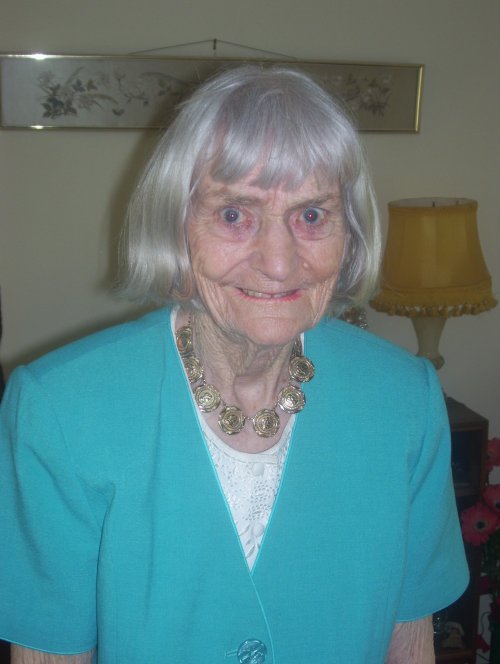 Dorothy Tyler, in her 90s, photo courtesy Dorothy Tyler
Dorothy Tyler, in her 90s, photo courtesy Dorothy Tyler
She competed in three British Empire Games (now the Commonwealth Games) in Sydney in 1938, Auckland in 1950 and Vancouver in 1954. She won two golds and a silver (Vancouver) in the high jump but also competed in the Javelin throw in all three (once coming fourth). In the 1954 British Empire Games also went in the long-jump and in 1950 in four events (high jump, long jump, javelin and 80m hurdles) I suppose the thinking was that if you were going to take an athlete all the way to New Zealand, you ought to get value for money by having them compete as often as possible.
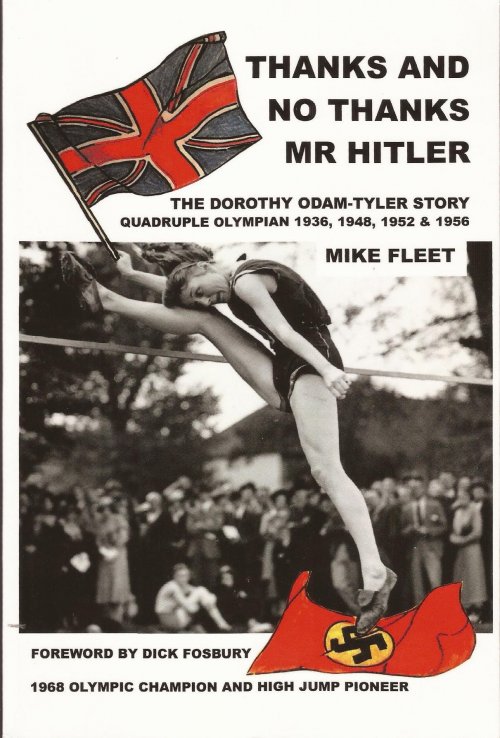 Thanks and No Thanks, Mr. Hitler, by Mike Fleet
Thanks and No Thanks, Mr. Hitler, by Mike Fleet
It is certainly tribute to her talent that she could be competitive in 3 or 4 events with minimal training while being a full-time mother.
Dorothy Odam-Tyler died on 25 September 2014 aged 94
Author

Since 2015, Stuart Weir has written for RunBlogRun. He attends about 20 events a year including all most global championships and Diamond Leagues. He enjoys finding the quirky and obscure story.
View all posts




















